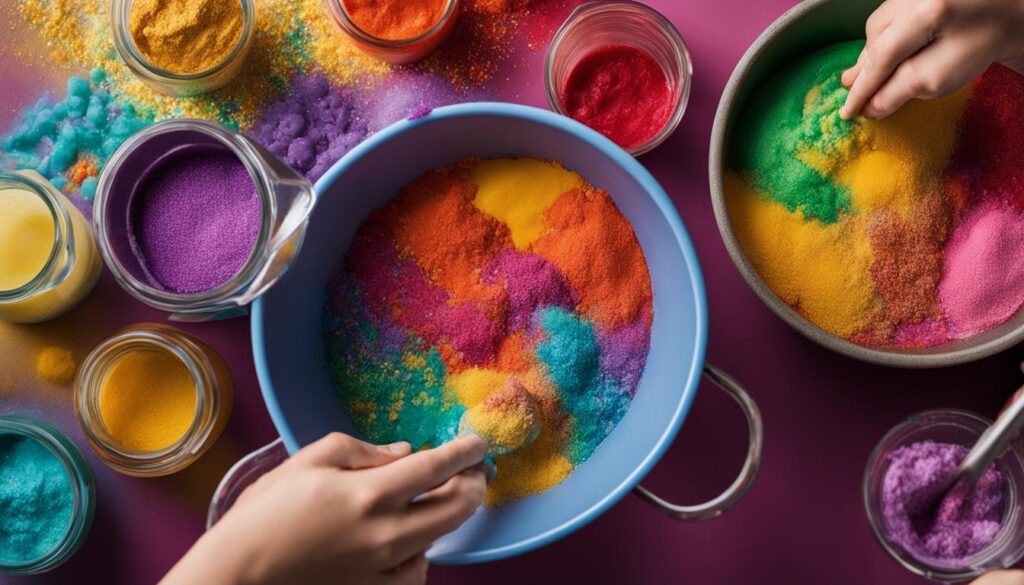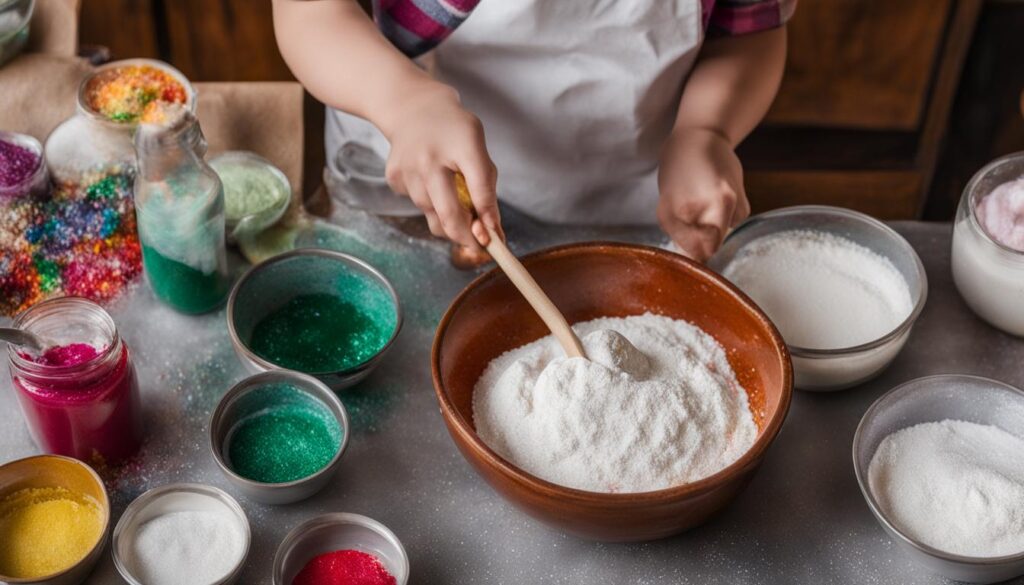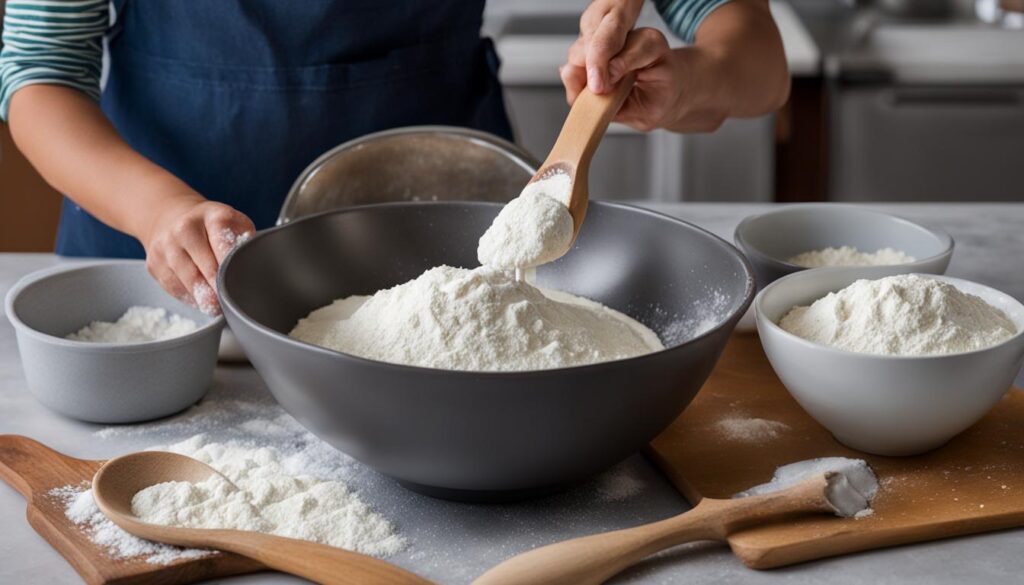

Greetings! Today, I am excited to explore the world of slime making with a unique twist – flour! Have you ever wondered if you can use flour to create a fun and satisfying slime concoction? Well, wonder no more! In this article, we will delve into the fascinating realm of flour slime recipes, alternative slime ingredients, and the joy of engaging in a DIY craft project that is suitable for everyone.
Key Takeaways:
- Flour can be used as a main ingredient to make slime, offering a safe and non-toxic alternative to traditional slime recipes.
- The process of making flour slime involves combining flour with glue, water, and optional food coloring to achieve a dough-like consistency.
- Flour slime provides hours of entertainment and can be enhanced with mix-ins like glitter or small toys.
- While flour is a popular choice for slime, there are other alternative ingredients such as cornstarch or laundry detergent that offer different textures and consistencies.
- Experimentation is key to finding the perfect flour slime recipe, and storing the slime in an airtight container helps prevent it from drying out.
How to Make Flour Slime: A Step-by-Step Tutorial
DIY slime has become a popular craft activity for both kids and adults. If you’re looking for an alternative slime recipe, you can make your own flour slime at home. It’s a simple and fun project that only requires a few basic ingredients. Here’s a step-by-step tutorial to guide you through the process of making homemade slime with flour.
What You’ll Need:
- All-purpose flour
- Glue
- Water
- Food coloring (optional)
- Mix-ins or decorations (optional)
1. In a bowl, combine the flour and glue. Mix them together until they are well combined. This will form the base of your slime.
2. Gradually add water to the mixture while stirring. Keep adding water until you achieve the desired consistency. Be mindful not to add too much water at once, as it can make the slime too runny.
3. If you’d like to add some color to your slime, you can mix in a few drops of food coloring. This will give your slime a vibrant and fun look.
4. Once the slime has formed, knead it with your hands until it becomes smooth and stretchy. This will help to activate the slime and give it the desired texture.
“Making flour slime is a great way to engage in hands-on creativity and sensory play. It’s an easy and inexpensive DIY project that can provide hours of entertainment for the whole family.” – Me
You can also add mix-ins like glitter or small toys to make your slime more interesting and visually appealing. Get creative and explore different options to personalize your slime.


Once you’ve finished playing with the slime, store it in an airtight container to prevent it from drying out. This way, you can enjoy your homemade flour slime for days to come. Remember to have fun and experiment with different colors and textures to create a unique slime recipe that suits your preferences.
Summary:
Making flour slime is a simple and enjoyable DIY craft project. By combining flour, glue, water, and optional mix-ins, you can create your own slime at home. Follow this step-by-step tutorial to make your own flour slime and enjoy hours of sensory play and creative fun. Remember to store your slime in an airtight container to keep it fresh.
Benefits and Considerations of Using Flour for Slime
When it comes to making slime, using flour as one of the main ingredients offers several benefits. First and foremost, flour is non-toxic, making it a safe alternative to slime recipes that involve chemicals like borax. This is especially important for younger children who may be more prone to putting things in their mouths. Flour slime is a great option for parents who want to provide a fun and creative activity for their kids without any potential harm.
Another advantage of using flour for slime is that it is easy to clean up. Unlike traditional slime recipes, flour slime doesn’t leave behind any sticky residue. This means less mess to deal with after the slime-making session, which parents will surely appreciate. Additionally, flour slime can be a budget-friendly option since flour is a common household ingredient that most people already have in their pantry.
However, it’s important to note that there are a few considerations when using flour for slime. The texture and consistency of flour slime may not be the same as other types of slime. The amount of water added to the mixture can affect the final result, so some experimentation may be needed to achieve the desired slime consistency. Some people may prefer alternative ingredients like cornstarch or laundry detergent for different textures and effects. It all comes down to personal preferences and desired results.
Flour and Water Slime Recipe:
| Ingredients | Instructions |
|---|---|
| 1 cup all-purpose flour | 1. In a mixing bowl, combine 1 cup of all-purpose flour with 1/2 cup of water. |
| 1/2 cup water | 2. Stir the mixture until it forms a dough-like consistency. |
| Food coloring (optional) | 3. Add a few drops of food coloring if desired, and continue to stir until the color is evenly distributed. |
| 4. Knead the slime with your hands until it becomes smooth and stretchy. |
Overall, using flour to make slime can be a fun and safe DIY craft project for everyone to enjoy. It offers a non-toxic alternative to traditional slime recipes and is easy to clean up. Just keep in mind that the texture and consistency of flour slime may vary, and it may require some experimentation to find the perfect recipe. Whether you choose to use flour, cornstarch, or other ingredients, the key is to have fun and get creative with your slime-making adventures!
Section 4: Tips for Creating the Best Flour Slime
When it comes to creating the best flour slime, there are a few tips and tricks to keep in mind. These simple suggestions can help you achieve the perfect consistency and texture for your homemade slime.
Use All-Purpose Flour
For the best results, it’s recommended to use all-purpose flour when making slime. Other types of flour may not provide the same consistency and can affect the overall texture of your slime. Stick with all-purpose flour to ensure a smooth and stretchy slime.
Add Water Gradually
Adding water to the flour and glue mixture is crucial for achieving the right slime consistency. It’s important to add the water gradually, as adding too much water at once can make the slime too runny. Pour the water slowly while stirring the mixture until you reach the desired thickness of slime.
Adjust the Consistency
If your slime is too sticky or too runny, don’t worry! You can easily adjust the consistency by adding more flour or water. If the slime is too sticky, gradually add more flour and knead it until it becomes less sticky. If the slime is too runny, add more water until it reaches the desired texture. Remember, it may take some trial and error to find the perfect consistency for your flour slime.


| Tip | Description |
|---|---|
| Use All-Purpose Flour | Stick with all-purpose flour to achieve a smooth and stretchy slime. |
| Add Water Gradually | Pour water slowly while stirring the mixture to avoid making the slime too runny. |
| Adjust the Consistency | Add more flour or water to achieve the desired texture of your slime. |
With these tips in mind, you’ll be able to create the best flour slime that is fun to play with and easy to handle. Remember to have fun and experiment with different colors and mix-ins to personalize your slime-making experience!
Exploring Other Slime Ingredients
When it comes to making slime, flour is not the only option. There are a variety of alternative ingredients you can experiment with to create different textures and consistencies. One popular choice is cornstarch, which can create a silky and stretchy slime. Simply mix cornstarch with water and any desired colorings or scents to create your own unique recipe.
Another alternative slime ingredient is laundry detergent. This option can create a gooey and stretchy slime that is easy to make. Just mix laundry detergent with glue and any other mix-ins you desire, and you’ll have a fun and colorful slime in no time.
If you’re looking for more natural alternatives, consider using chia seeds or tapioca pearls. Chia seeds can create a slimy texture when mixed with water, while tapioca pearls can add a fun and unique texture to your slime. These natural ingredients can provide a different sensory experience and are a great option for those who prefer more eco-friendly slime recipes.
When using alternative slime ingredients, it’s important to research specific recipes to ensure the best results. Each ingredient has its own properties and may require different ratios or preparation methods. By exploring different options, you can unleash your creativity and discover new and exciting slime recipes that everyone will love.
